B Ltd: Internal Control of Acquisition of Tangible Non-Current Assets
VerifiedAdded on 2020/07/22
|7
|1697
|39
Report
AI Summary
This report provides a comprehensive analysis of the internal control mechanisms employed for the acquisition and disposal of tangible non-current assets, specifically focusing on the case of B Ltd. It begins by defining tangible and non-current assets, emphasizing their significance in financial analysis. The report then delves into the strengths of the internal control system in place, highlighting the roles of various departments in the requisition, purchase, and recording processes. It underscores the importance of managerial oversight, purchasing officer checks, and financial accountant budget setting. Furthermore, the report outlines the steps for testing the control system, including risk identification, control exercises, test design, and analytical procedures. These procedures encompass comparing expenses and depreciation, calculating depreciation ratios, analyzing repair and maintenance costs, assessing insurance expenses, and reviewing capital budgets. The report concludes by summarizing the importance of assets in business development and the effective utilization of resources for achieving organizational goals. The report also includes references to relevant books and journals, and online resources.
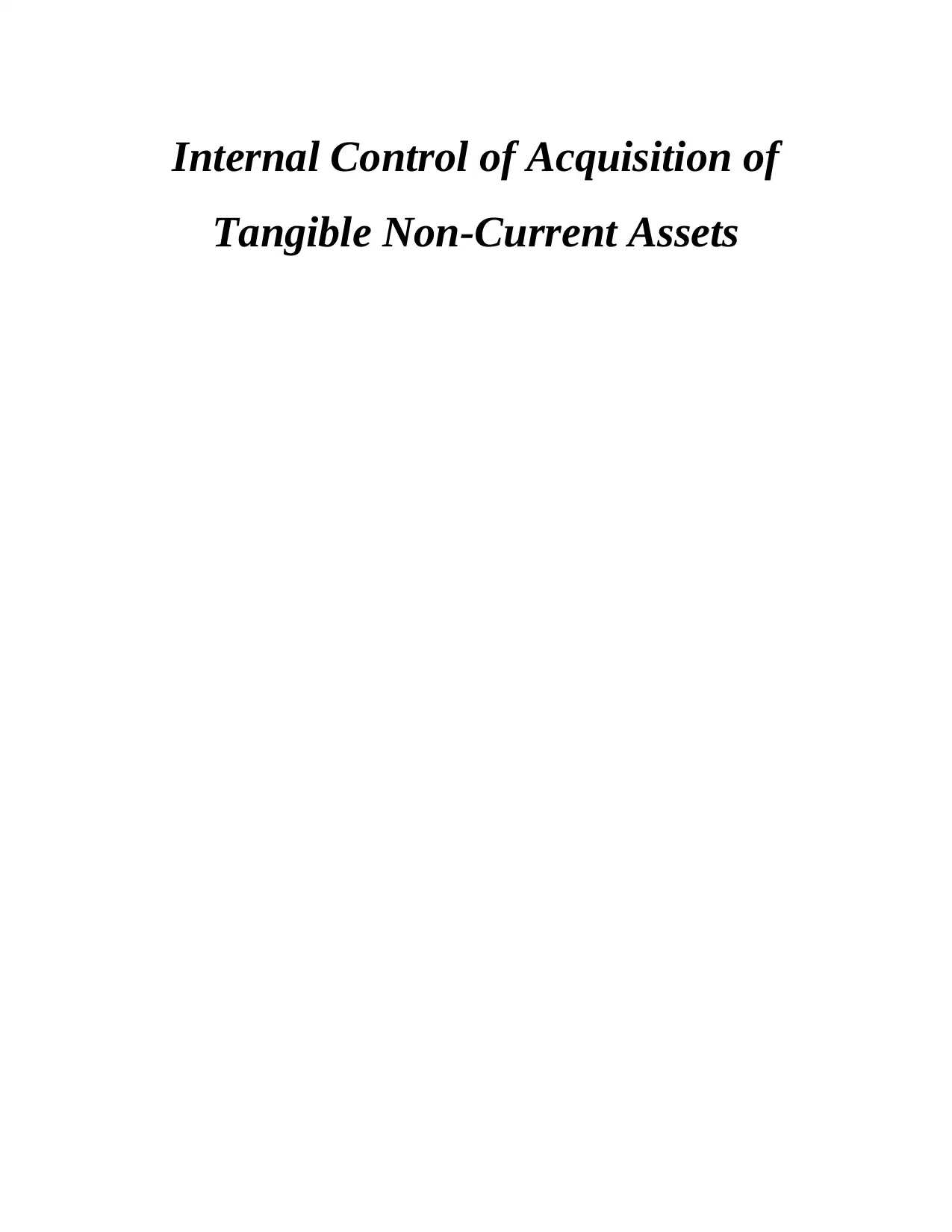
Internal Control of Acquisition of
Tangible Non-Current Assets
Tangible Non-Current Assets
Paraphrase This Document
Need a fresh take? Get an instant paraphrase of this document with our AI Paraphraser
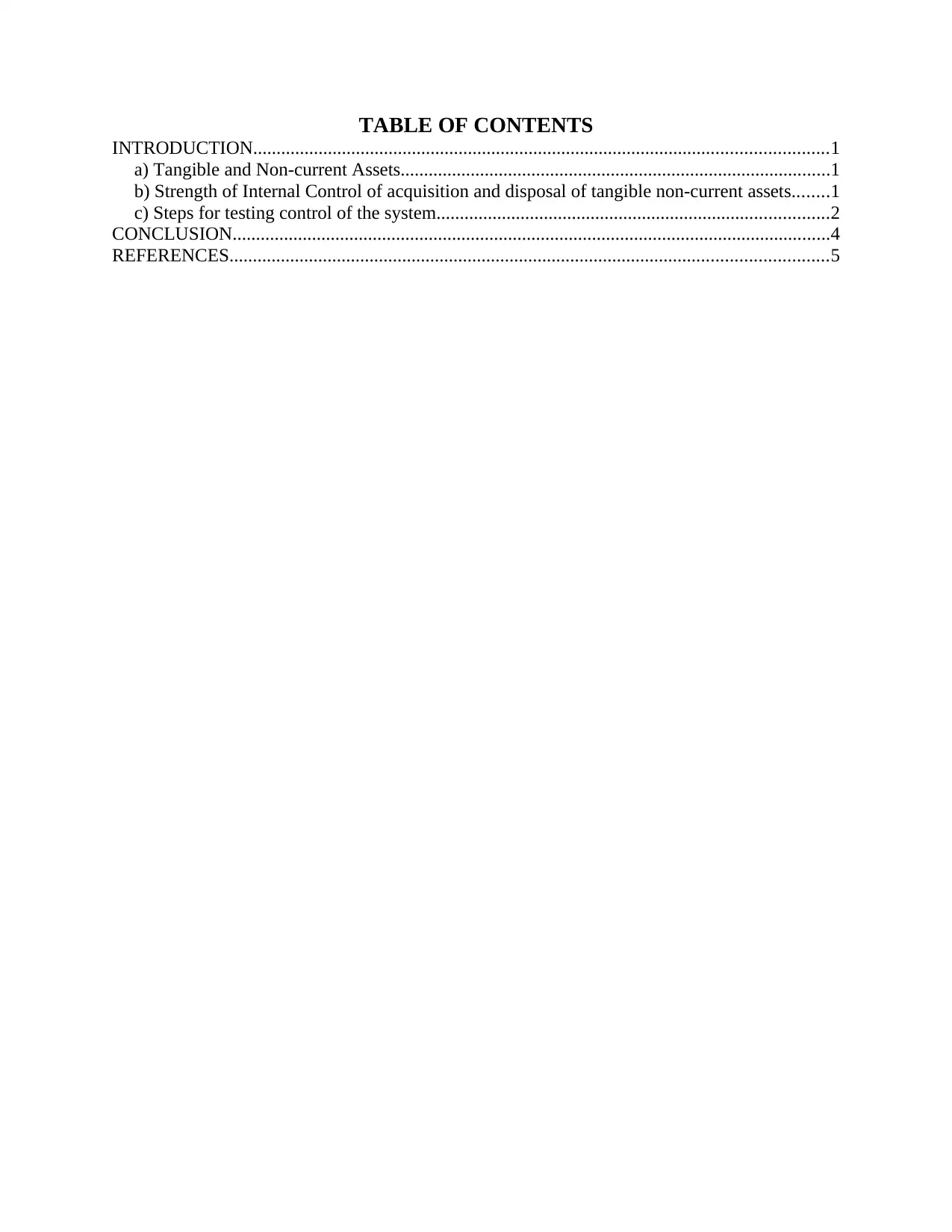
TABLE OF CONTENTS
INTRODUCTION...........................................................................................................................1
a) Tangible and Non-current Assets............................................................................................1
b) Strength of Internal Control of acquisition and disposal of tangible non-current assets........1
c) Steps for testing control of the system....................................................................................2
CONCLUSION................................................................................................................................4
REFERENCES................................................................................................................................5
INTRODUCTION...........................................................................................................................1
a) Tangible and Non-current Assets............................................................................................1
b) Strength of Internal Control of acquisition and disposal of tangible non-current assets........1
c) Steps for testing control of the system....................................................................................2
CONCLUSION................................................................................................................................4
REFERENCES................................................................................................................................5
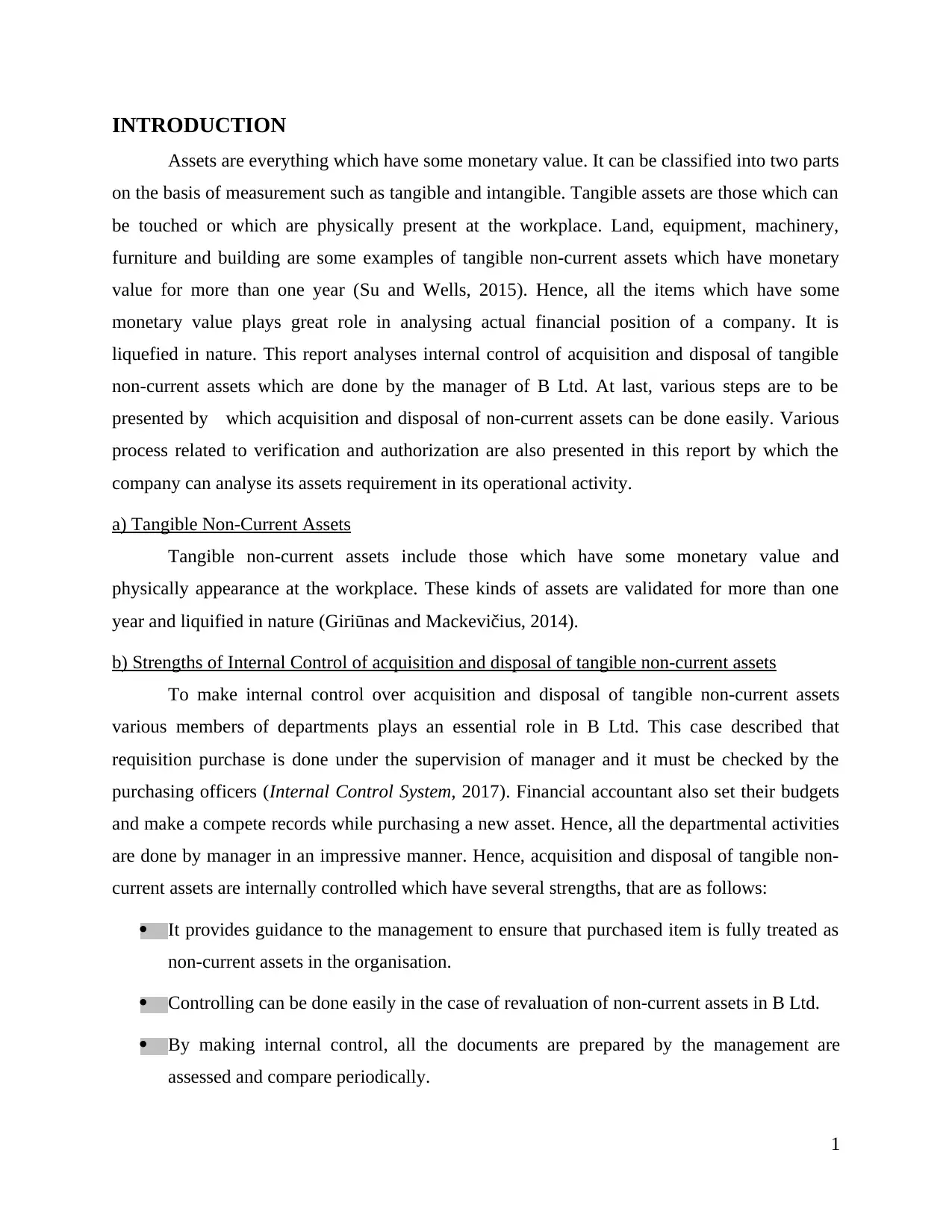
INTRODUCTION
Assets are everything which have some monetary value. It can be classified into two parts
on the basis of measurement such as tangible and intangible. Tangible assets are those which can
be touched or which are physically present at the workplace. Land, equipment, machinery,
furniture and building are some examples of tangible non-current assets which have monetary
value for more than one year (Su and Wells, 2015). Hence, all the items which have some
monetary value plays great role in analysing actual financial position of a company. It is
liquefied in nature. This report analyses internal control of acquisition and disposal of tangible
non-current assets which are done by the manager of B Ltd. At last, various steps are to be
presented by which acquisition and disposal of non-current assets can be done easily. Various
process related to verification and authorization are also presented in this report by which the
company can analyse its assets requirement in its operational activity.
a) Tangible Non-Current Assets
Tangible non-current assets include those which have some monetary value and
physically appearance at the workplace. These kinds of assets are validated for more than one
year and liquified in nature (Giriūnas and Mackevičius, 2014).
b) Strengths of Internal Control of acquisition and disposal of tangible non-current assets
To make internal control over acquisition and disposal of tangible non-current assets
various members of departments plays an essential role in B Ltd. This case described that
requisition purchase is done under the supervision of manager and it must be checked by the
purchasing officers (Internal Control System, 2017). Financial accountant also set their budgets
and make a compete records while purchasing a new asset. Hence, all the departmental activities
are done by manager in an impressive manner. Hence, acquisition and disposal of tangible non-
current assets are internally controlled which have several strengths, that are as follows:
It provides guidance to the management to ensure that purchased item is fully treated as
non-current assets in the organisation.
Controlling can be done easily in the case of revaluation of non-current assets in B Ltd.
By making internal control, all the documents are prepared by the management are
assessed and compare periodically.
1
Assets are everything which have some monetary value. It can be classified into two parts
on the basis of measurement such as tangible and intangible. Tangible assets are those which can
be touched or which are physically present at the workplace. Land, equipment, machinery,
furniture and building are some examples of tangible non-current assets which have monetary
value for more than one year (Su and Wells, 2015). Hence, all the items which have some
monetary value plays great role in analysing actual financial position of a company. It is
liquefied in nature. This report analyses internal control of acquisition and disposal of tangible
non-current assets which are done by the manager of B Ltd. At last, various steps are to be
presented by which acquisition and disposal of non-current assets can be done easily. Various
process related to verification and authorization are also presented in this report by which the
company can analyse its assets requirement in its operational activity.
a) Tangible Non-Current Assets
Tangible non-current assets include those which have some monetary value and
physically appearance at the workplace. These kinds of assets are validated for more than one
year and liquified in nature (Giriūnas and Mackevičius, 2014).
b) Strengths of Internal Control of acquisition and disposal of tangible non-current assets
To make internal control over acquisition and disposal of tangible non-current assets
various members of departments plays an essential role in B Ltd. This case described that
requisition purchase is done under the supervision of manager and it must be checked by the
purchasing officers (Internal Control System, 2017). Financial accountant also set their budgets
and make a compete records while purchasing a new asset. Hence, all the departmental activities
are done by manager in an impressive manner. Hence, acquisition and disposal of tangible non-
current assets are internally controlled which have several strengths, that are as follows:
It provides guidance to the management to ensure that purchased item is fully treated as
non-current assets in the organisation.
Controlling can be done easily in the case of revaluation of non-current assets in B Ltd.
By making internal control, all the documents are prepared by the management are
assessed and compare periodically.
1
⊘ This is a preview!⊘
Do you want full access?
Subscribe today to unlock all pages.

Trusted by 1+ million students worldwide
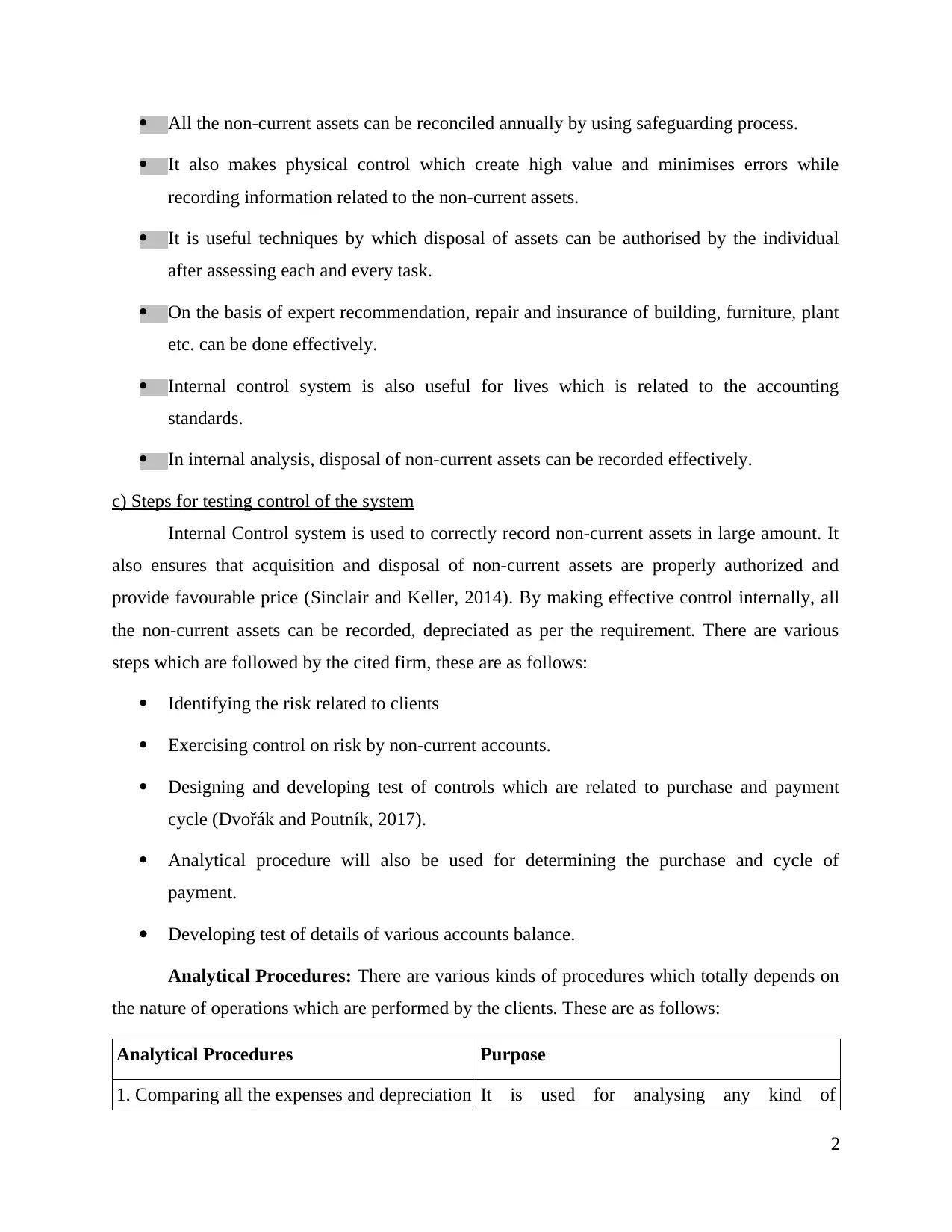
All the non-current assets can be reconciled annually by using safeguarding process.
It also makes physical control which create high value and minimises errors while
recording information related to the non-current assets.
It is useful techniques by which disposal of assets can be authorised by the individual
after assessing each and every task.
On the basis of expert recommendation, repair and insurance of building, furniture, plant
etc. can be done effectively.
Internal control system is also useful for lives which is related to the accounting
standards.
In internal analysis, disposal of non-current assets can be recorded effectively.
c) Steps for testing control of the system
Internal Control system is used to correctly record non-current assets in large amount. It
also ensures that acquisition and disposal of non-current assets are properly authorized and
provide favourable price (Sinclair and Keller, 2014). By making effective control internally, all
the non-current assets can be recorded, depreciated as per the requirement. There are various
steps which are followed by the cited firm, these are as follows:
Identifying the risk related to clients
Exercising control on risk by non-current accounts.
Designing and developing test of controls which are related to purchase and payment
cycle (Dvořák and Poutník, 2017).
Analytical procedure will also be used for determining the purchase and cycle of
payment.
Developing test of details of various accounts balance.
Analytical Procedures: There are various kinds of procedures which totally depends on
the nature of operations which are performed by the clients. These are as follows:
Analytical Procedures Purpose
1. Comparing all the expenses and depreciation It is used for analysing any kind of
2
It also makes physical control which create high value and minimises errors while
recording information related to the non-current assets.
It is useful techniques by which disposal of assets can be authorised by the individual
after assessing each and every task.
On the basis of expert recommendation, repair and insurance of building, furniture, plant
etc. can be done effectively.
Internal control system is also useful for lives which is related to the accounting
standards.
In internal analysis, disposal of non-current assets can be recorded effectively.
c) Steps for testing control of the system
Internal Control system is used to correctly record non-current assets in large amount. It
also ensures that acquisition and disposal of non-current assets are properly authorized and
provide favourable price (Sinclair and Keller, 2014). By making effective control internally, all
the non-current assets can be recorded, depreciated as per the requirement. There are various
steps which are followed by the cited firm, these are as follows:
Identifying the risk related to clients
Exercising control on risk by non-current accounts.
Designing and developing test of controls which are related to purchase and payment
cycle (Dvořák and Poutník, 2017).
Analytical procedure will also be used for determining the purchase and cycle of
payment.
Developing test of details of various accounts balance.
Analytical Procedures: There are various kinds of procedures which totally depends on
the nature of operations which are performed by the clients. These are as follows:
Analytical Procedures Purpose
1. Comparing all the expenses and depreciation It is used for analysing any kind of
2
Paraphrase This Document
Need a fresh take? Get an instant paraphrase of this document with our AI Paraphraser
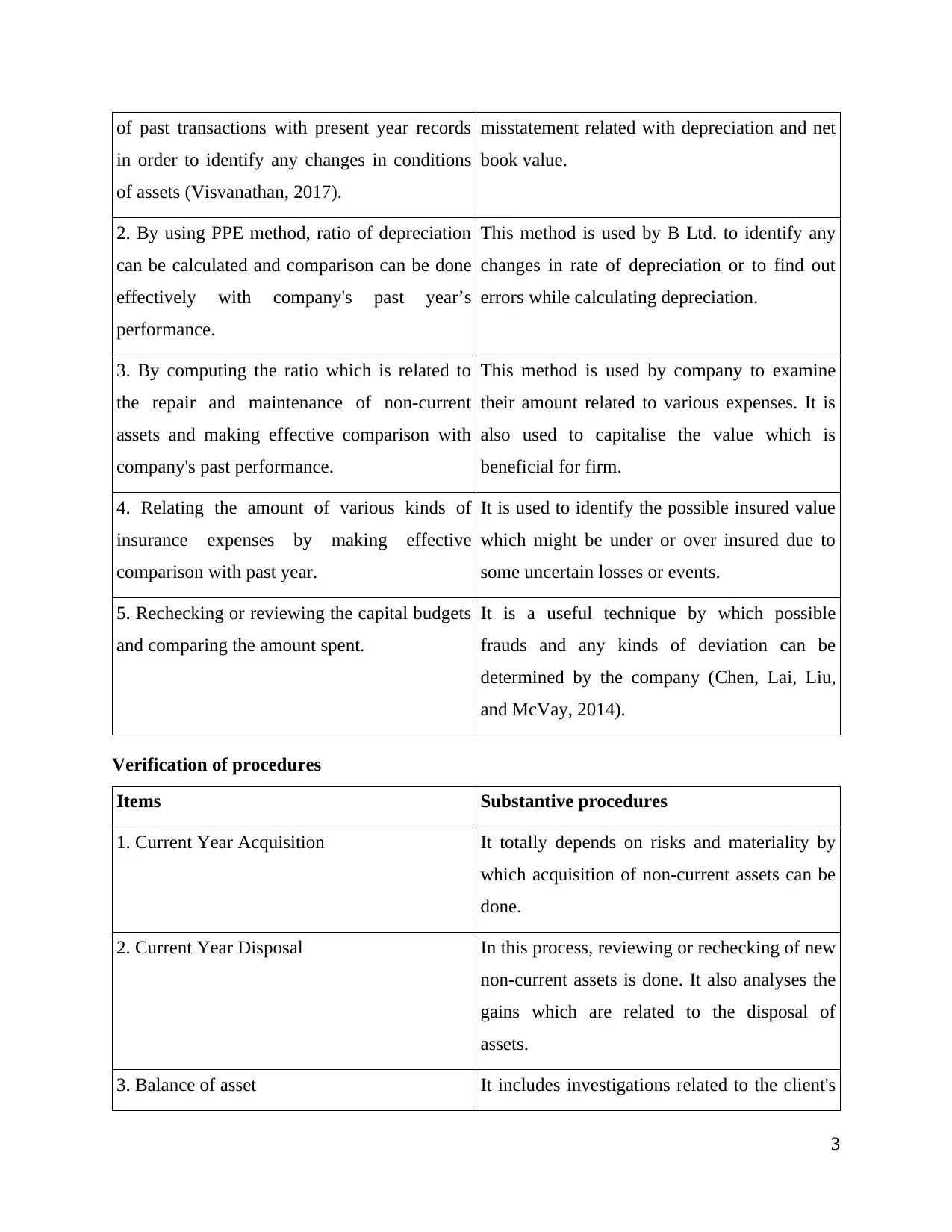
of past transactions with present year records
in order to identify any changes in conditions
of assets (Visvanathan, 2017).
misstatement related with depreciation and net
book value.
2. By using PPE method, ratio of depreciation
can be calculated and comparison can be done
effectively with company's past year’s
performance.
This method is used by B Ltd. to identify any
changes in rate of depreciation or to find out
errors while calculating depreciation.
3. By computing the ratio which is related to
the repair and maintenance of non-current
assets and making effective comparison with
company's past performance.
This method is used by company to examine
their amount related to various expenses. It is
also used to capitalise the value which is
beneficial for firm.
4. Relating the amount of various kinds of
insurance expenses by making effective
comparison with past year.
It is used to identify the possible insured value
which might be under or over insured due to
some uncertain losses or events.
5. Rechecking or reviewing the capital budgets
and comparing the amount spent.
It is a useful technique by which possible
frauds and any kinds of deviation can be
determined by the company (Chen, Lai, Liu,
and McVay, 2014).
Verification of procedures
Items Substantive procedures
1. Current Year Acquisition It totally depends on risks and materiality by
which acquisition of non-current assets can be
done.
2. Current Year Disposal In this process, reviewing or rechecking of new
non-current assets is done. It also analyses the
gains which are related to the disposal of
assets.
3. Balance of asset It includes investigations related to the client's
3
in order to identify any changes in conditions
of assets (Visvanathan, 2017).
misstatement related with depreciation and net
book value.
2. By using PPE method, ratio of depreciation
can be calculated and comparison can be done
effectively with company's past year’s
performance.
This method is used by B Ltd. to identify any
changes in rate of depreciation or to find out
errors while calculating depreciation.
3. By computing the ratio which is related to
the repair and maintenance of non-current
assets and making effective comparison with
company's past performance.
This method is used by company to examine
their amount related to various expenses. It is
also used to capitalise the value which is
beneficial for firm.
4. Relating the amount of various kinds of
insurance expenses by making effective
comparison with past year.
It is used to identify the possible insured value
which might be under or over insured due to
some uncertain losses or events.
5. Rechecking or reviewing the capital budgets
and comparing the amount spent.
It is a useful technique by which possible
frauds and any kinds of deviation can be
determined by the company (Chen, Lai, Liu,
and McVay, 2014).
Verification of procedures
Items Substantive procedures
1. Current Year Acquisition It totally depends on risks and materiality by
which acquisition of non-current assets can be
done.
2. Current Year Disposal In this process, reviewing or rechecking of new
non-current assets is done. It also analyses the
gains which are related to the disposal of
assets.
3. Balance of asset It includes investigations related to the client's
3
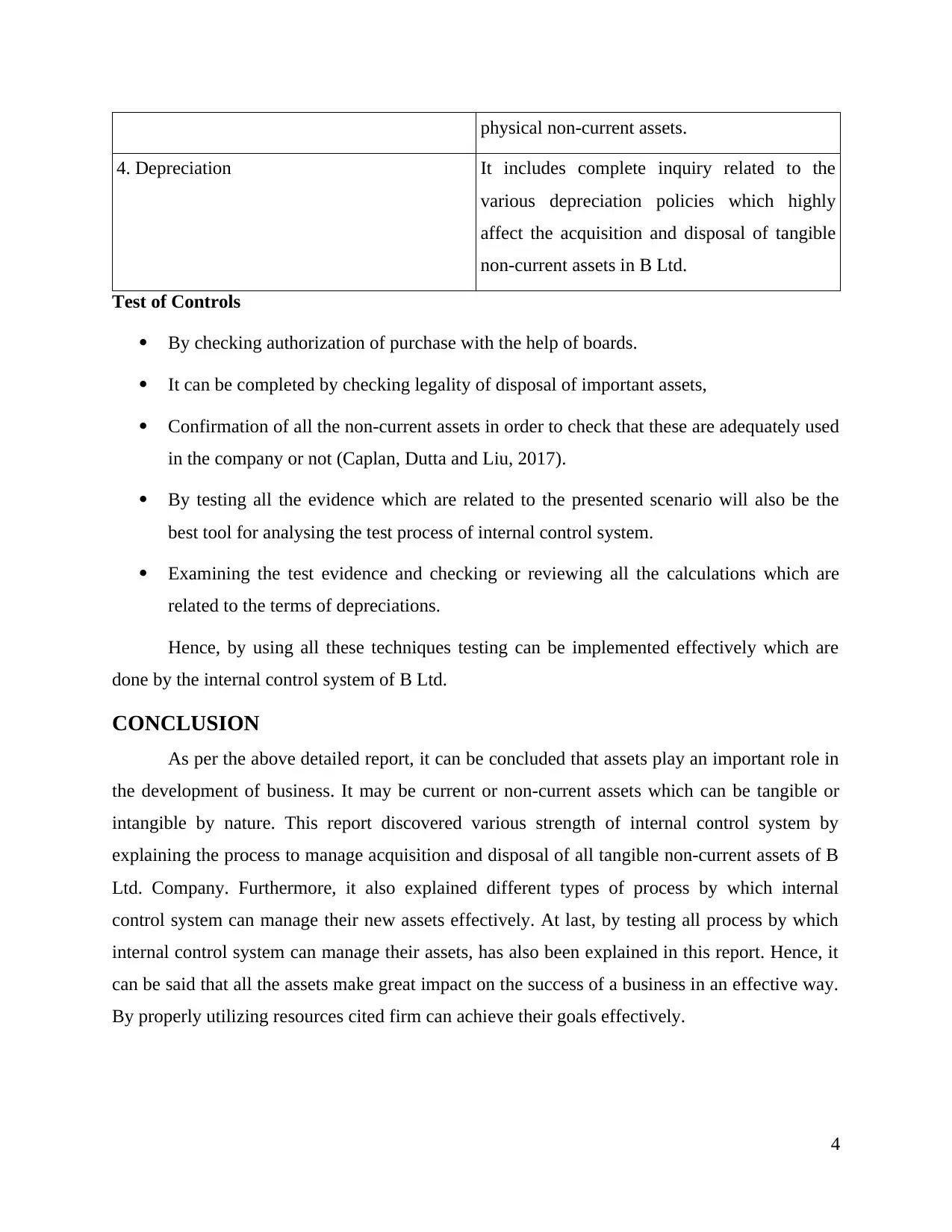
physical non-current assets.
4. Depreciation It includes complete inquiry related to the
various depreciation policies which highly
affect the acquisition and disposal of tangible
non-current assets in B Ltd.
Test of Controls
By checking authorization of purchase with the help of boards.
It can be completed by checking legality of disposal of important assets,
Confirmation of all the non-current assets in order to check that these are adequately used
in the company or not (Caplan, Dutta and Liu, 2017).
By testing all the evidence which are related to the presented scenario will also be the
best tool for analysing the test process of internal control system.
Examining the test evidence and checking or reviewing all the calculations which are
related to the terms of depreciations.
Hence, by using all these techniques testing can be implemented effectively which are
done by the internal control system of B Ltd.
CONCLUSION
As per the above detailed report, it can be concluded that assets play an important role in
the development of business. It may be current or non-current assets which can be tangible or
intangible by nature. This report discovered various strength of internal control system by
explaining the process to manage acquisition and disposal of all tangible non-current assets of B
Ltd. Company. Furthermore, it also explained different types of process by which internal
control system can manage their new assets effectively. At last, by testing all process by which
internal control system can manage their assets, has also been explained in this report. Hence, it
can be said that all the assets make great impact on the success of a business in an effective way.
By properly utilizing resources cited firm can achieve their goals effectively.
4
4. Depreciation It includes complete inquiry related to the
various depreciation policies which highly
affect the acquisition and disposal of tangible
non-current assets in B Ltd.
Test of Controls
By checking authorization of purchase with the help of boards.
It can be completed by checking legality of disposal of important assets,
Confirmation of all the non-current assets in order to check that these are adequately used
in the company or not (Caplan, Dutta and Liu, 2017).
By testing all the evidence which are related to the presented scenario will also be the
best tool for analysing the test process of internal control system.
Examining the test evidence and checking or reviewing all the calculations which are
related to the terms of depreciations.
Hence, by using all these techniques testing can be implemented effectively which are
done by the internal control system of B Ltd.
CONCLUSION
As per the above detailed report, it can be concluded that assets play an important role in
the development of business. It may be current or non-current assets which can be tangible or
intangible by nature. This report discovered various strength of internal control system by
explaining the process to manage acquisition and disposal of all tangible non-current assets of B
Ltd. Company. Furthermore, it also explained different types of process by which internal
control system can manage their new assets effectively. At last, by testing all process by which
internal control system can manage their assets, has also been explained in this report. Hence, it
can be said that all the assets make great impact on the success of a business in an effective way.
By properly utilizing resources cited firm can achieve their goals effectively.
4
⊘ This is a preview!⊘
Do you want full access?
Subscribe today to unlock all pages.

Trusted by 1+ million students worldwide
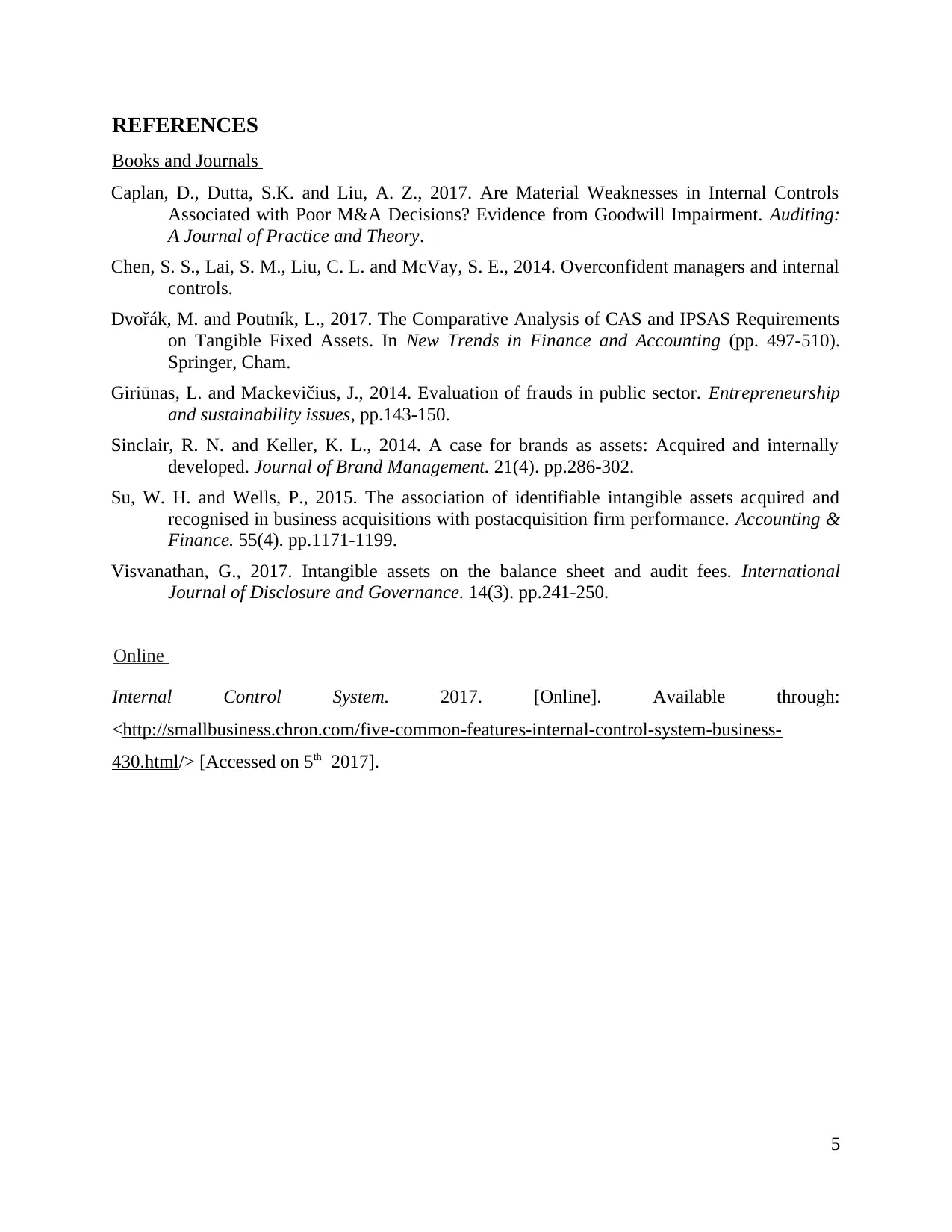
REFERENCES
Books and Journals
Caplan, D., Dutta, S.K. and Liu, A. Z., 2017. Are Material Weaknesses in Internal Controls
Associated with Poor M&A Decisions? Evidence from Goodwill Impairment. Auditing:
A Journal of Practice and Theory.
Chen, S. S., Lai, S. M., Liu, C. L. and McVay, S. E., 2014. Overconfident managers and internal
controls.
Dvořák, M. and Poutník, L., 2017. The Comparative Analysis of CAS and IPSAS Requirements
on Tangible Fixed Assets. In New Trends in Finance and Accounting (pp. 497-510).
Springer, Cham.
Giriūnas, L. and Mackevičius, J., 2014. Evaluation of frauds in public sector. Entrepreneurship
and sustainability issues, pp.143-150.
Sinclair, R. N. and Keller, K. L., 2014. A case for brands as assets: Acquired and internally
developed. Journal of Brand Management. 21(4). pp.286-302.
Su, W. H. and Wells, P., 2015. The association of identifiable intangible assets acquired and
recognised in business acquisitions with postacquisition firm performance. Accounting &
Finance. 55(4). pp.1171-1199.
Visvanathan, G., 2017. Intangible assets on the balance sheet and audit fees. International
Journal of Disclosure and Governance. 14(3). pp.241-250.
Online
Internal Control System. 2017. [Online]. Available through:
<http://smallbusiness.chron.com/five-common-features-internal-control-system-business-
430.html/> [Accessed on 5th 2017].
5
Books and Journals
Caplan, D., Dutta, S.K. and Liu, A. Z., 2017. Are Material Weaknesses in Internal Controls
Associated with Poor M&A Decisions? Evidence from Goodwill Impairment. Auditing:
A Journal of Practice and Theory.
Chen, S. S., Lai, S. M., Liu, C. L. and McVay, S. E., 2014. Overconfident managers and internal
controls.
Dvořák, M. and Poutník, L., 2017. The Comparative Analysis of CAS and IPSAS Requirements
on Tangible Fixed Assets. In New Trends in Finance and Accounting (pp. 497-510).
Springer, Cham.
Giriūnas, L. and Mackevičius, J., 2014. Evaluation of frauds in public sector. Entrepreneurship
and sustainability issues, pp.143-150.
Sinclair, R. N. and Keller, K. L., 2014. A case for brands as assets: Acquired and internally
developed. Journal of Brand Management. 21(4). pp.286-302.
Su, W. H. and Wells, P., 2015. The association of identifiable intangible assets acquired and
recognised in business acquisitions with postacquisition firm performance. Accounting &
Finance. 55(4). pp.1171-1199.
Visvanathan, G., 2017. Intangible assets on the balance sheet and audit fees. International
Journal of Disclosure and Governance. 14(3). pp.241-250.
Online
Internal Control System. 2017. [Online]. Available through:
<http://smallbusiness.chron.com/five-common-features-internal-control-system-business-
430.html/> [Accessed on 5th 2017].
5
1 out of 7
Related Documents
Your All-in-One AI-Powered Toolkit for Academic Success.
+13062052269
info@desklib.com
Available 24*7 on WhatsApp / Email
![[object Object]](/_next/static/media/star-bottom.7253800d.svg)
Unlock your academic potential
Copyright © 2020–2025 A2Z Services. All Rights Reserved. Developed and managed by ZUCOL.





